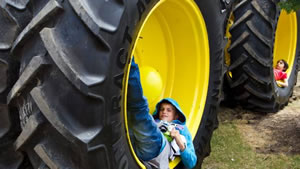Small, light robotics to take over big tractors as future for farm machinery
 Gerald Piddock for NZ Farmer: Farmers' love affair with big tractors could be over if they are to meet tighter environmental goals while maintaining production targets.
Gerald Piddock for NZ Farmer: Farmers' love affair with big tractors could be over if they are to meet tighter environmental goals while maintaining production targets.
Instead, larger farming machinery will be replaced by more efficient systems relying on emerging technologies, agricultural robotics expert Simon Blackmore said at the International Tri-Conference for Precision Agriculture in Hamilton.
The change would be disruptive, but worthwhile because it would make crop production more efficient than it is at the moment, he said.
"If we do that, we have more of a chance of feeding the planet, [have] less environmental impact and make more money."
Blackmore is a professor and head of agricultural robotics at the Agri-Epi-Centre and Harper Adams University and is also the director of the National Centre for Precision Farming in the United Kingdom.
While big, heavy farm machinery for cropping had increased work rates and reduced per hectare costs, they could not work in smaller fields, which had to be productive if farmers were going to feed the world.
"In my vision of agricultural robots in the future, I do see robots working in smaller fields, smaller farms and less developed areas," said Blackmore. Full Article:
Comments (0)
This post does not have any comments. Be the first to leave a comment below.
Featured Product

